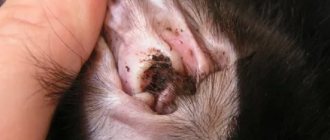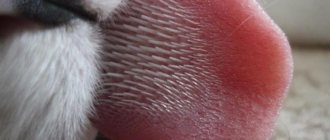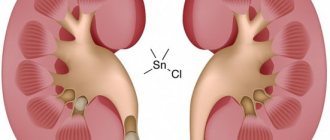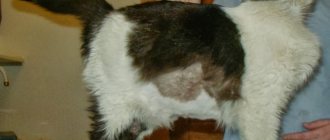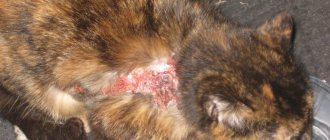The cat is a natural hunter with great agility to pursue prey. It is their keen sense of smell that helps them track this prey in the first place. Their sense of smell is not only useful when they hunt, but also helps them learn as much as possible about their surroundings. With a utility like this, anything that could harm your sense of smell could endanger your cat's overall well-being. Swelling or inflammation this is one of the most obvious signs that our cat has a problem.
At HowMeow.ru we look at what happens when your cat has a swollen nose . It is important that you recognize this symptom as abnormal and seek immediate veterinary attention. If this doesn't happen, the threat to your health could be much worse than losing your ability to smell.
Symptoms associated with a swollen cat nose.
As with any medical condition in a cat, we must observe the context surrounding a cat with a swollen nose. This is especially true when we don't know the origin of the problem. By considering any other possible symptoms, we can better determine the underlying cause of the inflammation and help our veterinarian determine the best treatment option. These symptoms include:
- Facial deformity (cat with a swollen face)
- Nasal or eye discharge.
- Tearing
- Conjunctivitis
- Nasal congestion
- Cough
- Sneezing
- Breath sounds
- Loss of appetite
- Fever
- Apathy
- Bloody discharge
Although we may not be able to diagnose the problem ourselves, providing as much information as we can can help achieve an accurate diagnosis as quickly as possible.
This means monitoring behavioral changes as well as any physical symptoms that may occur...
Cat nose swollen from foreign bodies
A foreign body lodged in a cat's nasal passage is one of the most common causes of a swollen nose . Cats love to explore and smell anything. Just like their reputation, a cat's curiosity can get them into trouble. They may push their face or inhale something that causes significant damage to them. A foreign object can come in a variety of sizes, but anything stuck in your sinuses is no good. Some of the most common objects that are placed in a cat's nose include:
- Seeds
- Espinas
- Plastic parts
- Insects
- Sand/earth
We can be alerted the first time a dog's nose is swollen due to their sneezing, something that is likely to happen when they have a foreign body stuck in their nose. There may also be mucus discharge that accompanies the problem. We'll have to look at the upper respiratory tract to see if there's anything there. However, we must try to be aggressive, which may cause more damage...
Cat nose swollen from insect bites
While this can happen to any cat, those with access to the outside are more likely to be bitten by bugs, parasites, or other insects. This is because the environment is home to many of these creatures... Insects and arachnids that may bite or bite your cat's nose and cause swelling include:
- Wasp
- Bee
- Scorpion
- Mosquito
- I'm a bug
- Spider
The cause of swelling is a disease in cats. Immune response . Once the tissue detects the presence of a pathogen, the cat's immune response sends antibodies to its location and inflammation occurs when fighting it.
Parasites such as ticks and fleas can also cause swelling in a cat's nose. They are not as likely to be found here as they are to favor other body parts. In these cases, in addition to swelling, you may see the cat trying to scratch its nose to relieve the itching...
Likewise, contact with certain plants that are toxic to cats can cause inflammation . If the swelling is a reaction to a toxic substance, it may be accompanied by redness, sneezing and scratching, among other symptoms...
Allergic swollen cat nose
Inflammation is one of the main symptoms of an allergic reaction in cats. The nose and face of cats are no exception. Depending on the type of allergy, inflammation may spread to other areas. If the allergen is airborne, when the cat inhales it, the nose and mouth may initially become swollen. This is similar to the case when a cat suffers from food allergies, since the allergens first come into contact with the mouth and face.
In general, all cat allergies will have the following symptoms:
- Localized erythema (redness)
- Localized swelling/inflammation
- Itching (itching)
- Increased body temperature.
- Sneezing
While a swollen nose may not be serious, large amounts of allergens can cause a more severe reaction. In these cases, the cat may go into anaphylactic shock . This is a severe and rapidly developing systemic allergic reaction. Symptoms of this reaction include:
- Swelling of the lips, tongue, face, neck and even the whole body.
- Difficulty swallowing
- Shortness of breath (trouble breathing)
- Disease
- Vomit
- Abdominal pain
- Fever
- Death (if not treated promptly)
The severity of swelling and other symptoms depends on the time of exposure and the amount of allergens present.
This is a veterinary emergency, so take your pet to the veterinarian as soon as possible if you notice symptoms.
Treatment of the disease
If a sore appears under the cat’s nose, treatment should be started immediately. To do this, you need to contact a veterinarian who will prescribe the appropriate medications. The owners themselves can treat a sick animal at home. To do this they need
:
- isolate him from other cats;
- give the cat medications strictly as directed by the doctor;
- wipe the face with a wet cotton swab several times a day to remove discharge;
- cleanse the nasal passages with nasal drops for 5 days;
- lubricate sores in the mouth and nose with Lugol's solution;
- ventilate and humidify the air in the room;
- if you refuse food, feed and water the cat from a syringe;
- Severe dehydration can be eliminated by subcutaneous or intravenous administration of saline.
Calcivirosis is a serious, long-term and insidious disease that can last up to 1 month, so you should not stop treatment at the first signs of improvement in your cat’s condition, but patiently wait for the disease to be completely cured. After all, an untreated disease can come back, but this time in a more severe form.
The cause of the appearance of crusts may be injury - the thin sensitive skin of a cat's nose is easily injured. The cat could have scratched its nose during play, in a fight with fellow tribesmen, or in an unfortunate fall from a height. Examine the animal - if no damage is visible, the cat may have had a nosebleed and the crust has formed dry. Gently wipe your pet's face with damp cotton wool - if the crusts come off easily and the skin underneath is not changed, the cat behaves calmly, breathing is not difficult, most likely, the danger has already passed, but it is better to show the animal to a veterinarian to exclude injuries to internal organs.
If a cat's nose is scratched, there is no need to separate the crust - once it dries, it will come off on its own. Do not let the cat tear off the crust while washing, and if it interferes with his breathing, soften it with warm water, chlorhexidine or Vaseline oil, remove and lubricate the exposed skin with a wound-healing preparation, preferably with antibacterial components in the composition.
Cat nose swollen from abscess
When a cat has an abscess on the face, we may see significant swelling . This swelling occurs due to the accumulation of pus. This phenomenon usually causes swelling of the cat's face and nose. An abscess may be a lump under the skin, but if it breaks through the skin, it may create a sore. The main causes of an abscess are:
- Dental problems: When the root of one or more teeth becomes infected, an abscess forms below and causes local swelling of the face. A very painful abscess can push up and make it look like a swollen nose.
- An injury such as a scratch or blow to the face is a fairly common reason why your cat's nose becomes swollen. This can happen if they are hit with something sharp, scratched too hard, or get into a fight with another animal. When bacteria enter the wound area, they can cause inflammation.
Treating abscesses in cats requires cleaning and disinfecting the wound area. In more severe cases, it may be necessary to drain the abscess and use antibiotics to treat the problem...
Prevention
Walking your cat on a leash will help you avoid unnecessary injuries or fights with other animals.
To reduce the likelihood of facial swelling in cats, veterinarians recommend that owners carefully monitor their pets. It is better not to let them go outside alone, which will protect the animals from fights, injuries and bites. Walking without an owner is most dangerous for cats that are over 3 months old. Their fear has already disappeared, but the kittens have not yet fully grown up to adequately assess the threats and fight back the offender.
It is important for cat owners to remember that industrial complementary foods sold in stores can cause allergic reactions. If a decision has been made to diversify your pet’s diet with a new food, it is recommended to introduce it gradually, observing the response of the animal’s body. An important preventive measure is a systematic examination of the cat, its ears, eyes, nose and mouth. You should attend routine medical examinations with your pet at a veterinary clinic, which will help identify the development of pathologies at the initial stages.
Under no circumstances should you ignore a situation where a cat's nose or other part of its face is swollen. The thing is that the reason may lie not only in external pathologies (allergies, bacterial infection, insect bite), but may also indicate an inflammatory process in the oral cavity.
Very often, abscesses on the gums are accompanied by severe swelling of the cheeks, eyes and nose area.
Feline cryptococcosis and swollen nose.
Cryptococcosis in cats is caused by the fungi cryptococcus neoformans or cryptococcus gatti. These fungi are present in soil, bird droppings and some plants. They can be transmitted by inhalation. The result can be a pulmonary granuloma, a structure formed by inflammation due to various diseases. Immune cells known as macrophages attempt to coat and coat the agent or pathogen (in this case a fungus) to prevent damage.
Cryptococcosis also affects dogs, ferrets, horses and humans. The condition is more common. Asymptomatic , meaning it has no visible symptoms. When clinical symptoms occur, they usually involve nasal problems, problems affecting the nervous system, skin problems, or other systemic reactions. Nasal symptoms are characterized by nasofacial inflammation accompanied by ulcers and nodules in the area.
Another very common symptom is that the cat's face is swollen, called a clown nose . This is associated with characteristic swelling of the nose and inflammation of the paranasal sinuses. Other symptoms include sneezing, runny nose and swollen lymph nodes. A cat very often has a runny nose and visible bloody discharge, especially when he sneezes.
To positively identify cryptococcosis in a cat, a biopsy and/or fungal culture is usually performed. The fungus can remain dormant for months or even years before symptoms appear, making it very difficult to determine its origin...
Cryptococcosis treatment in cats
If your cat has cryptococcosis, you will want to know what treatment options are available. Treatment of fungal diseases can take a long time. The minimum is usually about 6 weeks and can take up to 5 months for successful treatment. The most used medications to treat cryptococcosis are:
- Itraconazole
- Fluconazole
- Ketoconazole
In these cases, it is important to protect the liver. Since the drug is metabolized in the liver, we may see negative changes in this organ. Additionally, if there are secondary skin lesions and wounds in the cat's nose, topical or systemic antibiotic treatment may be prescribed, cleaning and disinfection will be performed by a veterinarian.
You should never treat your cat yourself. This can cause other adverse reactions that can worsen symptoms and possibly even kill the animal. Vestibular syndrome is one such complication...
What is edema?
Fluid retention in animal tissues occurs for various reasons.
There are two mechanisms for fluid accumulation:
- hydrostatic, associated with increased pressure in small vessels;
- hypoprotemic, associated with a violation of the protein content in the liquid part of the blood (plasma).
In the latter case, the permeability of small vessels increases due to inflammation, disorders of nervous regulation or toxic lesions.
The fluid that accumulates in the tissues can also be different:
- blood;
- lymph;
- pus.
Edema may vary in area and symmetry:
- they are limited (localized) and generalized (general);
- symmetrical and asymmetrical (for example, only one paw swells).
Limited swelling affects a small area of the body or organ. General ones cover large areas and indicate serious illnesses and a poor prognosis for the life of the animal.
Edema is caused by a condition called pre-edema. Predotec describes the state of preliminary accumulation of fluid in organs or tissues.
Swollen viral infections in a cat's nose
Feline aids virus (fiv), feline leukemia virus (felv), herpes virus or calicivirus can also cause nasal inflammation. This may also be accompanied by sneezing and even sores and scabs on the cat's nose. Each disease will also have other specific symptoms associated with it. A viral sinus infection, such as rhinitis, can also cause nasal inflammation...
Treatment for the virus usually involves managing the symptoms of the condition. Antiviral medications may be available, but this will depend on the specific disease and clinical condition of the individual cat. Likewise, it is very important to ensure that your cat's vaccination schedule is up to date to avoid contracting the virus...
Some of the causes of a cat's swollen nose are not the only possibilities. Here are some other reasons that can lead to a sore nose:
Nasopharyngeal duct obstruction
The nasopharyngeal duct is a small structure that connects the lacrimal gland (where tears originate) and the nasal cavity. It can be blocked, just like the sinuses. These blockages may be due to the accumulation of secretions, foreign bodies or bacteria.
Respiratory disorders
Breathing disorders, whether acute or chronic, can affect the nasal cavity and nasopharynx . Rhinitis (a type of sinus infection) and asthma are among the most common. If you notice any respiratory symptoms, such as sneezing, nasal or eye discharge, coughing, or difficulty breathing, you should take your cat to a veterinary center before symptoms worsen.
Neoplasia or nasal polyps
A neoplasm or nasal polyp is a growth of mucous membrane in the paranasal sinuses . Due to direct or indirect airway obstruction, the cat may also have the above symptoms.
Sporotrichosis
Sporotrichosis in cats is a fungal disease and is usually treated with an antifungal agent such as itraconazole. It is a zoonosis, meaning it can be transmitted to humans. Pathogens can enter an animal through open wounds, animal bites or scratches, which usually affect the mouth and nose.
This article is purely informational. HowMeow.ru does not have the right to prescribe veterinary treatment or diagnose. We invite you to take your pet to the vet if you are suffering from any illness or pain.
Reasons why cats lose hair
Veterinarians identify several reasons that can affect hair loss, which becomes significant and worries the owner:
- Seasonal molt
. This process may not cause concern if the hair loss is severe, but the cat does not experience discomfort. His nose is moist, his skin is clear, normal color, and there is no discharge from his eyes. If your cat has lost hair on her neck, this may be a sign of shedding. This is a natural and normal seasonal process. In pets, it can last for almost three months. This, of course, annoys the owners who have to remove scraps of fur. But new vegetation will grow to replace the old one, and we just need to help the process and promote its growth. This can be done by enriching the cat's nutritional diet with natural foods rich in minerals and vitamins. - Diet
. Nutrition has a significant impact on all body functions, as well as on the condition of the skin and hair. An unbalanced diet can lead to a condition that causes cats to lose hair profusely, especially on the back, tail, and neck. The rest may become dull. The most unpleasant thing for a cat can be redness, peeling and itching of the places where it fell out. This most often occurs when feeding a pet sausage, sausages, and in general foods high in fat, spices and salt. We also note the fact that a large amount of whole milk in an animal’s diet can cause hair loss. - Hormonal disorders
. Veterinarians note that often owners of animals who are given drugs that suppress attraction to the opposite sex complain that their hair is falling out a lot. In this case, wounds and ulcers may appear at the site of baldness. A change in the pet’s behavior was also noticed: lethargy, loss of appetite, as well as a change in body weight towards a decrease or significant increase. - Allergic reactions
. Cats are prone to allergies, mainly food ones. Certain products can cause hair loss and a number of unpleasant symptoms: inflammation of the ears, redness of the skin in areas of bald patches and severe itching that bothers the animal; the cat is constantly itching. - Immune problems
. A disease suffered by a pet and drug treatment can cause severe hair loss. But this is only a temporary phenomenon that will gradually pass when the body gets stronger. - Facial alopecia
. This term describes hair loss in cats between the eyes and ears. The process is natural and does not relate to the disease. It can appear in a cat between the second and third years of life.
